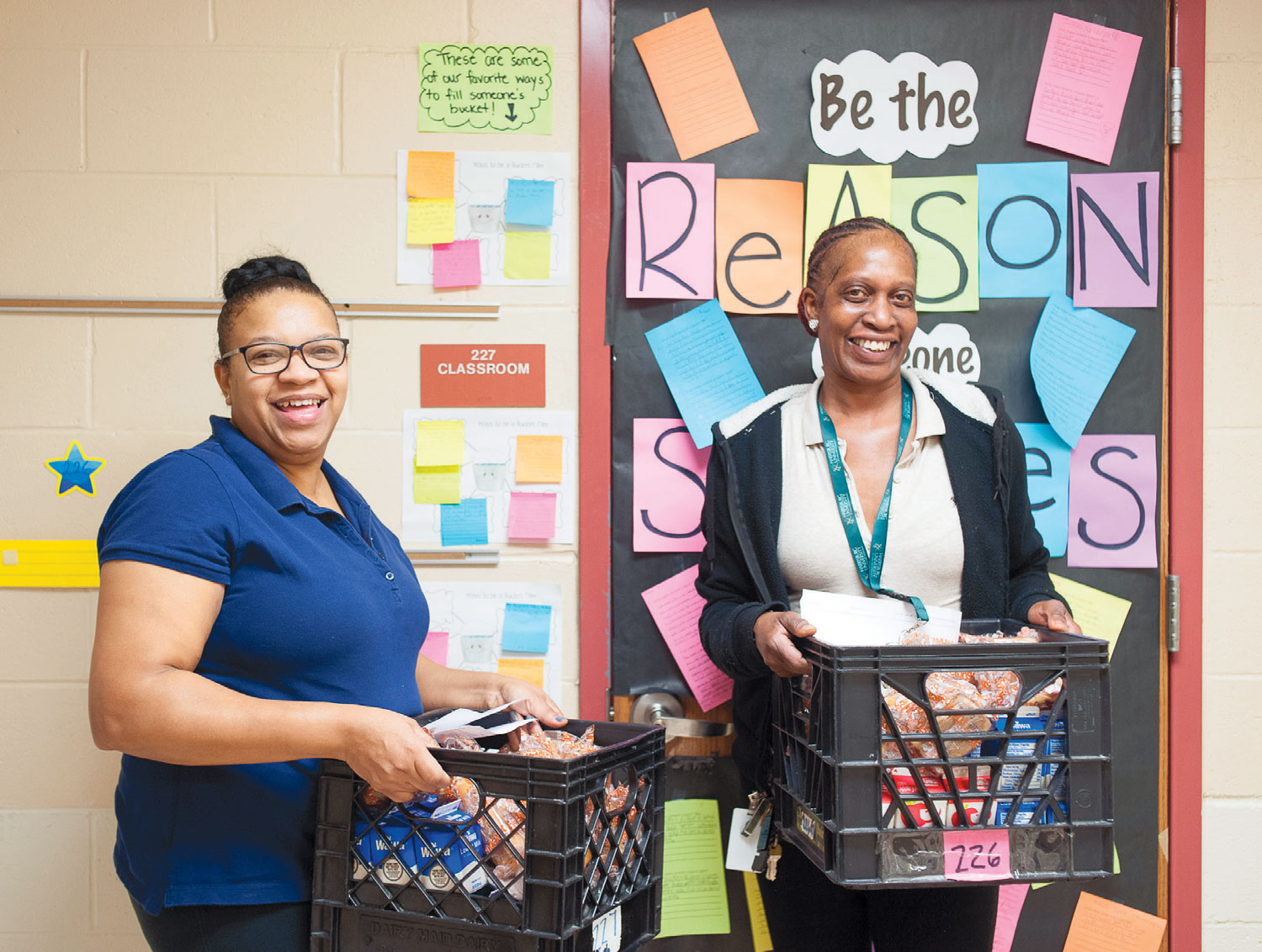The School Breakfast Challenge
How Philadelphia schools are ramping up breakfast programs—and why it’s a city priority
Just after eight on a recent Monday morning, fourth-graders at H.A. Brown Elementary School in East Kensington quietly filed into Mrs. McGlynn’s classroom, hung their coats on labeled hooks, and settled in at desks arranged in groups of four. Mrs. McGlynn reminded them to start working on their daily language review.
Also part of this routine was that Rebecca Brown, that day’s “breakfast boss,” pulled milk cartons, juice packs, and yogurt cups from a crate at the back of the classroom. It was her job to unpack the meal and make sure her classmates came to get their food.
“White table!” she called. As students selected their morning meal, Rebecca made notes. “Everyone that takes a breakfast. I check off their names,” she explained.
Though some students grabbed just a carton of milk or juice, many took the full meal back to their desks. One corrected sentences on his worksheet between spoonfuls of yogurt.
This is a setup that many Philadelphia schools are implementing. Breakfast is free, there’s enough for everyone, and the in-class routine takes the stigma out of eating a school-provided meal.
During the past three years, the Philadelphia School District, city councilwoman Helen Gym, and local organizations like the Food Trust and the Coalition Against Hunger have pushed to increase participation in school breakfast programs. Kids are more focused and ready to learn when their stomachs are full, but many families don’t have the resources to provide a morning meal.
“People know that Philadelphia is the largest poor city in the country,” says Gym, chair of the City Council’s Children and Youth Committee. “We have so many children who come to school hungry, who go home to households with empty refrigerators and pantries. Schools have a major role to play in offsetting that.”
Under the US Department of Agricultures’s Community Eligibility Provision (CEP), established in 2014, it’s been easier for Philadelphia schools to provide more meals. Because 80 percent of students in the district qualify for federal assistance programs, all schools can now offer free breakfast and lunch to every student, without collecting individual household applications. Administrators and parents are freed up from time-consuming paperwork, and stigma is eliminated when the meals free for everyone.
But to reach 70 percent of students with a morning meal—the school district’s goal—making breakfast free isn’t incentive enough.

A student unpacks the morning meal for her classmates.
“Any staff at school telling a student to eat
is not nearly as effective as their peer telling
them to try breakfast,” Fisher says.
The Food Trust, along with Temple University’s Center for Obesity Research and Education, recently completed a five-year study to assess breakfast habits and their effect on obesity among fourth through sixth-graders.
In 2013, the team took a close look at breakfast patterns among youth in food-insecure families. They collected surveys from 821 students in 16 schools about where they consumed breakfast and what they ate.
Almost half of these kids, 46 percent, live in food-insecure households. They are less likely to have nutritious diets (that is, they eat fewer whole grains and fruits and more added sugars), and more likely to have lower test scores than their food-secure peers, according to the study. They’re the kids who need that morning meal at school the most.
But the results showed that 16.9 percent of these students skipped breakfast altogether, and few were consistently eating breakfast at school despite free access. The researchers wanted to understand why hungry kids were passing on free meals and figure out how schools could change that.
As it turns out, the way the morning meal is offered has a big impact on participation. The school-breakfast status quo—serving meals in a cafeteria before the morning bell—isn’t the most effective setup to entice kids to eat.
“Students don’t want to get up early and go into the cafeteria,” says Dr. Sandy Sherman, director of nutrition education at the Food Trust and co-principal investigator on the study. “They don’t want to have the perception that they need breakfast.” In other words, it makes kids feel different and self-conscious—so much so that they’d rather not do it at all. Furthermore, not every kid can get to school early enough to eat.
That’s why the district is encouraging administrators to serve breakfast after the bell. Grab-and-go carts stationed in the hallway work well for middle-school and high-school students: they can stop and pick up a meal on their way to class and eat it during first period. And serving breakfast in the classroom has been found to double or even quadruple the number of meals eaten.

Students complete daily worksheets while enjoying breakfast.
“We used to have breakfast in the cafeteria, but you’d have to get here at eight. Now we can just come straight [to class] and eat breakfast here.”
H.A. Brown was among the first schools in the district to overhaul its breakfast program. The school serves more than 500 students in kindergarten through eighth grade. “Over 90 percent of our students are designated as economically disadvantaged,” says Principal Connie Carnivale.
When Principal Carnivale was hired in 2012, she knew that many of her students were coming to school hungry. “We were getting maybe 25 to 30 percent of our students coming to breakfast,” she says. Back then, they served breakfast in the cafeteria before the bell, but most students couldn’t make it in early enough. The program “just wasn’t getting breakfast to as many students as we felt needed to be reached,” Carnivale says.
Former governor Corbett’s education cuts—which eliminated $100 million in charter reimbursements to the Philadelphia district— made it impossible for H.A. Brown to pay extra staff to serve a meal before school. Principal Carnivale and her teachers were committed to feeding their students, so they decided to implement a whole-school breakfast in the classroom program.
Food-service staff members Brenda Walton and Marlow Williams got to Brown at 6:30 that morning to distribute breakfast—in crates they packed the previous day—to each classroom, as they do every morning. Williams, who’s worked at H.A. Brown for more than 15 years, was cheery as she did her morning rounds. She wore a green apron over a purple polo, a thick braid wrapped up in a bun, maneuvering two rolling carts stacked high with crates. Just after seven, she had delivered them all.
When the kids come into class, they have the first 20 minutes to eat and settle in. They can journal, complete a daily worksheet, or talk with their deskmates. The time has proven valuable. “Sharing conversations over a meal with their peers was really improving their socialization,” Principal Carnivale says. Classmates get along and are happier at school.
H.A. Brown now achieves some of district’s the highest attendance rates, around 94 percent. Better attendance leads to better overall student performance: “This year we saw an increase in our test scores and in our state ranking,” says Carnivale.
Carnivale and her staff were recognized for their improvement by Mayor Jim Kenney, School Superintendent William R. Hite Jr., and Councilwoman Gym during National School Breakfast Week last spring. (You can learn more about this program, sponsored by the School Nutrition Association each March, at schoolnutrition.org.) H.A. Brown’s breakfast program is just what they want to model for other schools in the district.

Breakfast crates packed up for delivery the next morning.
“My biggest hope for
the program is that as
schools start to make
a commitment to ending
childhood hunger, they
also recognize
the ways in which food
helps build a sense of
community.”
To get even more kids eating school breakfast, the Coalition Against Hunger partnered with the Food Trust, the School District, and Councilwoman Gym’s office to hold the School Breakfast Challenge last year.
Kathy Fisher, policy director at the Coalition Against Hunger, worked with the district to recruit schools to enter the challenge, which measured breakfast participation from October to December 2017 and compared it with the same three-month period in 2016.
The 42 schools that signed up received tools to improve their programs, including guidelines for implementing breakfast-after-the-bell programs and breakfast lessons from the Food Trust’s nutrition educators. They also recruited youth leaders to encourage kids to eat the morning meal. “Any staff at school telling a student to eat is not nearly as effective as their peer telling them to try breakfast,” Fisher says.
The schools with the biggest percentage increases from 2016 to 2017 will receive awards in the spring.
A clear leader in the challenge is Francis Scott Key Elementary School in South Philly. For all but the youngest students, who file into the cafeteria to eat at the start of the school day, Principal Pauline Cheung and her staff have implemented breakfast in the classroom.
“I appreciate all the support the school district has given to my school in making breakfast a priority for our students,” Principal Cheung said at an event in January. It hasn’t been an easy achievement for the oldest operating school in the district, built in 1889. The building doesn’t have a full-service kitchen, and there’s limited prep area—a problem in many Philadelphia schools.
“In order to expand breakfast in a number of schools, it has to be through breakfast in the classroom,” says Wayne Grasela, vice president of the district’s Division of Food Services. “What we’ve done to encourage principals to do this is to offer them additional resources [and] additional food service employees to coordinate the program.”
The district has also funded a full-time food-service position at Key School. Grasela and his team are monitoring improvements, hoping to achieve a three-year goal across the district: 40 to 50 percent participation this year, 50 to 60 percent next year, and 60 to 70 percent by the 2019—20 school year.
Key School is reaching those numbers already—it saw a 66 percent increase in the first year of the new breakfast program.
What’s made the program catch on so fast? Cheung says it’s the student engagement. “Breakfast ambassadors” retrieve a breakfast bag from the cafeteria and bring it up to their classroom every morning.
Fifth-grade students Marco, Billy and Jebarn deliver breakfast to their peers in Mr. Halko’s classroom. “They don’t need me,” Halko says. “They’ve got a routine—these breakfast ambassadors have it covered.”
The kids like the new system, too. “We used to have breakfast in the cafeteria, but you’d have to get here at eight,” says Billy, who’s a big fan of the sausage, egg and cheese burrito served that day. “Now we can just come straight up and eat breakfast here.”
They work on homework or talk with their peers while they eat. Just like at H.A. Brown, the classroom environment has improved, which has led to better attendance rates. A morning meal goes a long way in supporting the vibrant learning environment the school seeks to provide.
“My biggest hope for the program is that as schools start to make a commitment to ending childhood hunger, they also recognize the ways in which food helps build a sense of community,” Gym says. Breakfast in the classroom encourages students to take a moment to relax, share a story with classmates and get to know each other.
“We should be thoughtful about how that time can be utilized. Not only [should we] give children the best, most nutritious breakfast,” Gym adds, but staff, parents, and communities should also realize “how it can contribute to a sense of belonging and community in the school and in a child’s life.”





